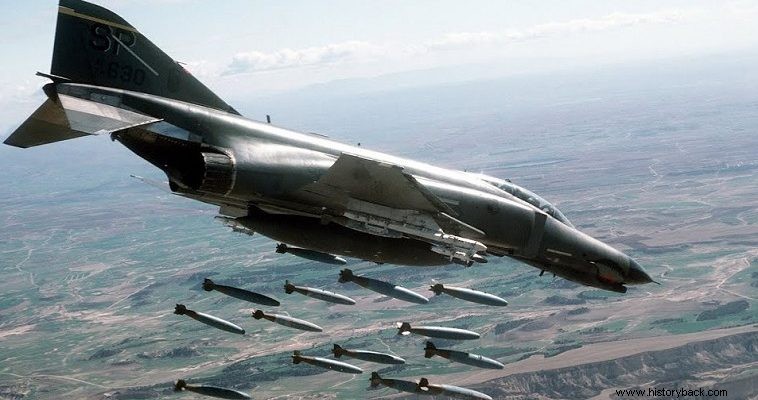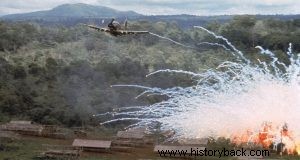
The air war over North Vietnam was a result of the policy of "retaliation" that the American political leadership decided to implement. Rightly so, the Americans calculated that aerial bombardment would "bring the North to its knees", as they said at the time, and indeed without a great cost in blood, since the North Vietnamese did not have an organized air defense system to challenge American air superiority.
In this light, the air attacks against North Vietnam were planned, in two directions. The first of these was the tactic of mass attacks, with a large number of aircraft, continuously. The second envisaged an escalating air campaign, depending on the military and political reactions of the enemy.
In particular it provided for retaliatory strikes whenever the enemy launched some form of attack against American or South Vietnamese targets. With this logic, the first air operations, "Flaming Dart I" and "Flaming Dart II", were carried out as responses to the enemy attacks on Pleikos - February 7, 1965 - and Qui Non - February 10, 1965. It followed from 2 March 1965 the operation "Rolling Thunder".
But contrary to American expectations, the North had been significantly reinforced by their allies with fighter jets, anti-aircraft guns, radars and above all with surface-to-air guided missiles, mainly SA-2. So when the Americans started the air war the Vietnamese were able to react.
Commencement of shelling
In the early stages of Operation Rolling Thunder, the main American target was the Tan Hoa Bridge - a strategically important bridge, through which the railway line connecting the North and the South passed. The Americans considered its destruction a rather easy task. On April 4, 1965, American F-105 fighters took off with a mission to destroy the bridge. They would be accompanied by F-100 Super Saber fighters
North Vietnamese air defenses were immediately alerted and 4 MiG-17s took off to intercept the invaders. The Americans were completely taken by surprise and before they could react two of their aircraft were shot down, by the old but serviceable Soviet fighters. This was only a warning of what was to come. American reconnaissance soon spotted dozens of anti-aircraft missile launch sites.
On July 24, one of them achieved the first downing of its kind, with a Phantom of the American Air Force being the victim. The Americans soon found that their opponents had organized their defense in three echelons. Anti-aircraft missiles were the backbone of the enemy's air defense. The launch sites were simultaneously covered by a dense network of anti-aircraft guns, of various calibers – from 27 to 100 mm.
It is worth noting that the North's anti-aircraft guns were responsible for most of the downing of American aircraft. The third element of North Vietnamese air defense was the available Soviet fighters – initially MiG-17s and later MiG-19s and MiG-21s. With the exception of the last type, the first two were in no way equal to the corresponding American aircraft.
For this reason the Northerners used their aircraft sparingly, for point interception, assigning the main roles to missiles and anti-aircraft guns. The Vietnamese MiGs usually charged at maximum speed, on the "tails" of the American attackers, firing heat-guided missiles at them and machine-gunning them.
They were not engaged in a dogfight with them. Air battles were of course fought, but this was not the usual practice. And in many cases, because the Americans used to attack enemy missile positions furiously, the Vietnamese built fake missile positions, which they covered with a multitude of anti-aircraft guns .
Technology vs. Stubbornness
The Americans, for their part, mobilized their technological superiority, using electronic warfare aircraft and electronic countermeasures against enemy radars and missiles. Thanks to electronic countermeasures, the Americans carried out their first successful raid against enemy missile sites on October 17, 1965.
American countermeasures blinded enemy radars, allowing a squadron of A-4 Skyhawks and a squadron of Navy A-6 Intruders to destroy an enemy missile site north of Hanoi. Gradually the Americans adopted the tactic of attacking enemy missile positions in two phases.
First the Wild Weasel aircraft detected the enemy radar emissions and hit them with anti-radar missiles and second time the tactical bombers came to destroy the enemy formations. The Vietnamese responded by shutting down their radars. in this way, however, the effectiveness of their rockets was annihilated.
The first MiG downing occurred on June 17, 1965, when two Phantoms from the aircraft carrier USS Midway spotted 4 MiG-17s. American operators Page and Batson shot down by an enemy aircraft with Sparrow guided missiles.
The strangest dogfight, however, took place between two A-1 Skyraider attack helicopters and two MiG-17s. Taking advantage of their lower speed, the American aircraft, with continuous close maneuvers, managed to shoot down an enemy aircraft. The American Air Force achieved the first downs on July 10, 1965. And here the perpetrators were the F-4 Phantoms that shot down two enemy with Sidewinder missiles.
The Americans planned an operation to trap enemy aircraft and destroy as many of them as possible. The "Bolo" business assigned to the 8th Fighter Wing. The Americans, instead of sending their regular fighters to hit the enemy targets, as they always did, covering them with F-4 Phantoms, sent only the Phantoms.
The Vietnamese, believing that the tracks they spotted on their radar screens were American bombers, took off fighter jets to intercept them. However, they were surprised to find that they had the best enemy fighters in front of them. A fierce air battle followed in which the Vietnamese lost 7 aircraft.
Infrastructure and failure
Operation Rolling Thunder continued with various variations. The Americans understood that if they wanted to achieve real results they had to abandon the tactics of retaliation and focus on serious tactical, strikes against enemy infrastructure , perhaps also in limited-scale strategic "sub-strategic" bombings.
With this rationale they launched an air campaign against enemy infrastructure – ports, warehouses, refineries, bridges, roads and of course the Ho Chi Minh Strip, a favorite target of the B-52s. At the same time, air mines were laid on the rivers and raids against the enemy air bases. Raids against the industrial infrastructure of the North followed.
However the 'Rolling Thunder' operation ultimately failed. The reasons for its failure are simple. First, the Americans, as usual, underestimated North Vietnamese air defenses. The second reason was even simpler. Aerial bombardment can cripple a fighting nation, destroying its industrial infrastructure, its technical infrastructure, and perhaps its wider manufacturing base, depriving it of the means to continue the war.
In the case of North Vietnam, this doctrine could not apply, since the country had a rudimentary industrial infrastructure, the destruction of which, in no way affected its ability to continue the war, since all weapons and materials were supplied by China and the USSR For the same reason the destruction of ports and port facilities played only a secondary role for the North Vietnamese.
As for the bridges and roads, these were repaired, sometimes, and in just a few hours, after the American bombings, by numerous crews of soldiers and civilians. After all, the Vietnamese gradually found other solutions, crossing the rivers with ferries at night and carrying the supplies on difficult, completely invisible from the air paths, on bicycles, or on their shoulders. In Vietnam American technology was literally humiliated by the weak shoulders of the Vietnamese soldiers.
The same happened to the Ho Chi Minh Corridor, which through Laos, was the main supply route for the South Viet Cong fighters throughout the war. The Americans mobilized against him their behemoths, the B-52s, whose every attack changed the landscape. Despite this, the traffic never stopped in the corridor.
The Americans were counting on a German-style air campaign, ignoring the fact that neither in World War II did their strategic bombings succeed in destroying the industrial infrastructure of a highly industrialized nation, such as Germany, nor in bending the will of the Germans for continuation of the war.

